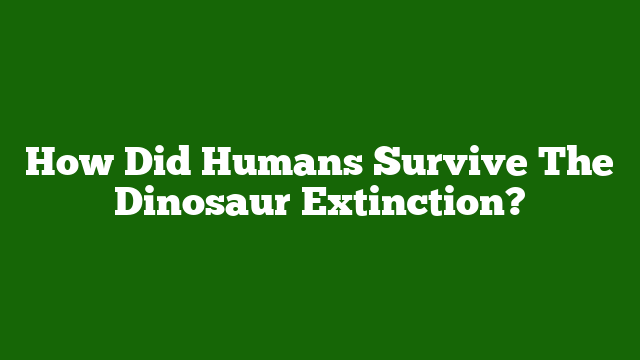Last Updated on June 12, 2023 by Umar
The extinction of dinosaurs, which occurred around 66 million years ago, was a cataclysmic event that wiped out nearly 75% of life on Earth
However, some species managed to survive, including small mammals, crocodiles, and birds
This blog post will explore the factors that allowed these species to survive and how humans, who evolved much later, were able to thrive in the aftermath of the dinosaur extinction.
The Dinosaur Extinction Event
The most widely accepted theory for the extinction of dinosaurs is the impact of a large asteroid or comet, known as the Chicxulub impactor, which struck the Earth near the present-day Yucatán Peninsula
This impact caused massive fires, tsunamis, and a significant amount of vaporized rock, ash, and dust to rise into the atmosphere, blocking sunlight and causing a dramatic drop in global temperatures
This led to the extinction of many species, including the non-avian dinosaurs.
Survival of Mammals and Other Species
Despite the catastrophic effects of the asteroid impact, some species managed to survive.
Crocodiles, small mammals, and even some tenacious plants were able to persist in the harsh conditions following the impact
The key to their survival was their ability to adapt to the dramatic changes in the environment.
For example, mammals bulked up in size rather than evolving bigger brains, allowing them to better adapt to the new conditions
.
The Evolution of Homo Sapiens
Humans, or Homo sapiens, did not exist during the time of the dinosaurs.
The lineage of Homo sapiens began around 550,000 to 750,000 years ago
As time went on, the bodies and brains of early hominins evolved, along with their tools and technologies
The extinction of the dinosaurs opened up new ecological niches for mammals to exploit, leading to a rapid diversification and expansion of mammalian species.
One of the earliest known primates, Purgatorius, survived the extinction event and lived during the Paleocene epoch
This small, shrew-like creature was an ancestor of modern primates, including humans.
Over millions of years, the descendants of Purgatorius and other early mammals evolved into a wide variety of species, eventually giving rise to Homo sapiens
.
Conclusion
Humans did not exist during the time of the dinosaurs, and therefore did not need to survive the extinction event.
However, the extinction of the dinosaurs created new opportunities for the ancestors of humans and other mammals to thrive.
The ability of these early mammals to adapt to the dramatic changes in the environment following the asteroid impact allowed them to survive and diversify, eventually leading to the evolution of Homo sapiens.
Today, humans are the dominant species on Earth, thanks in part to the extinction of the dinosaurs and the resilience of our early mammalian ancestors.
Helpful Resources
- https://interactive.wttw.com/prehistoric-road-trip/stops/how-did-anything-survive-the-mass-extinction
- https://www.amnh.org/exhibitions/dinosaurs-ancient-fossils/extinction/discarded-theories
- https://www.amnh.org/explore/news-blogs/research-posts/mammal-adaptations-after-dinosaur-extinction
- https://www.smithsonianmag.com/science-nature/essential-timeline-understanding-evolution-homo-sapiens-180976807/
- https://www.smithsonianmag.com/science-nature/fossil-site-reveals-how-mammals-thrived-after-death-of-dinosaurs-180973404/
- https://www.bbc.com/future/article/20220812-dinosaur-extinction-why-did-mammals-survive

